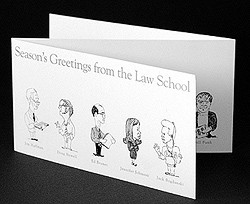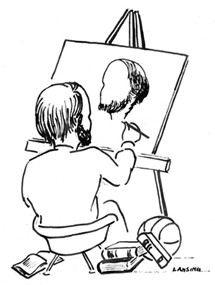Lansing’s caricatures create law school tradition

When he walked into the exam room the next day, he strolled to the chalkboard and taped up a caricature of his professors at Willamette University College of Law.
“I drew the backs of their heads,” says Lansing, professor of law at Lewis & Clark Law School. “I depicted them sitting in a group, watching ‘Divorce Court’ on television and looking for questions to use on the exam.”
That was his first caricature.
Lansing continued to sketch, or as he says, to doodle, after he came to Lewis & Clark. During his 35 years at the law school, he has created a “rogue’s gallery of every full-time tenured or tenure-track law professor.” His work is so popular that bidding is brisk each year when the Public Interest Law Project puts his services up for auction.
Last February, the law school’s 2000 holiday card, which featured 31 of Lansing’s caricatures, won a Gold Award from the Council for Advancement and Support of Education District VIII. The College’s Office of Publications, which is now part of the Office of Public Affairs and Communications, produced the card.
Though Lansing never took an art class, he has a natural creative flair. He not only sketches but is an accomplished writer of books and stories about historical trials in Oregon and the Old West.
Sitting in his softly lit office, replete with antique puzzles and memorabilia of the American West, Lansing describes his creative process. Defining a caricature, he says, is easy. It’s a picture of a person drawn with exaggerated features to achieve a comical result. How Lansing comes up with the final image is a bit of a mystery, even to him.
The process works best when Lansing is able to observe his subjects in action. He generates most initial sketches during faculty meetings. To relieve tension or to alleviate boredom, he doodles on a lined yellow legal pad. Faces, hands, body postures, and mannerisms all play a role. So do hairstyles, beards, clothing, and other props, such as pipes and eyeglasses.
“Does this remind you of anyone?” Lansing asks his colleagues as the meetings disband. And, like any good poker player, which Lansing is, he scrutinizes their faces. Their reactions tell him whether he’s on the mark.
During the next three to four months, Lansing tweaks his drawing in the same manner that he rewrites his book chapters to achieve the right “turn of a phrase.” Eventually, he traces the pencil sketch and redraws it in permanent ink on art paper.
Lansing’s framed caricatures, arranged in chronological order, grace the lower-level hallways of the Legal Research Center.
“Law is not just science, it’s also art,” notes Lansing, who teaches classes in evidence and torts. “It’s important to me to help students understand that reason and imagination are not incompatible; that logic and creativity have the same soul; that laws, while sometimes schooled in gospel, have their genesis in vision.”
—by Pattie Pace

Above: Ron Lansing’s Self Portrait
More L&C Magazine Stories
Lewis & Clark Magazine is located in McAfee on the Undergraduate Campus.
MSC: 19
email magazine@lclark.edu
voice 503-768-7970
fax 503-768-7969
The L&C Magazine staff welcomes letters and emails from readers about topics covered in the magazine. Correspondence must include your name and location and may be edited.
Lewis & Clark Magazine
Lewis & Clark
615 S. Palatine Hill Road MSC 19
Portland OR 97219

